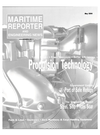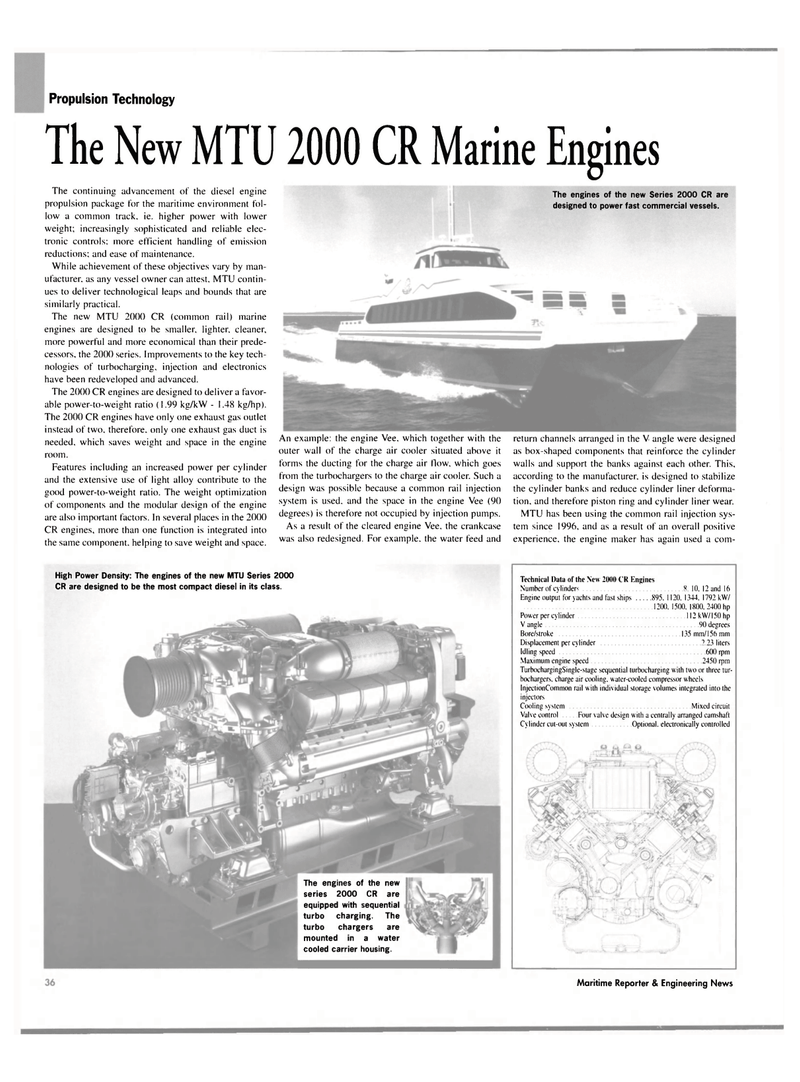
Page 40: of Maritime Reporter Magazine (May 2004)
The Propulsion Technology Yearbook
Read this page in Pdf, Flash or Html5 edition of May 2004 Maritime Reporter Magazine
Propulsion Technology
The New MTU 2000 CR Marine Engines
The continuing advancement of the diesel engine propulsion package for the maritime environment fol- low a common track, ie. higher power with lower weight; increasingly sophisticated and reliable elec- tronic controls; more efficient handling of emission reductions; and ease of maintenance.
While achievement of these objectives vary by man- ufacturer, as any vessel owner can attest. MTU contin- ues to deliver technological leaps and bounds that are similarly practical.
The new MTU 2000 CR (common rail) marine engines are designed to be smaller, lighter, cleaner, more powerful and more economical than their prede- cessors, the 2000 series. Improvements to the key tech- nologies of turbocharging, injection and electronics have been redeveloped and advanced.
The 2000 CR engines are designed to deliver a favor- able power-to-weight ratio (1.99 kg/kW - 1.48 kg/hp).
The 2000 CR engines have only one exhaust gas outlet instead of two, therefore, only one exhaust gas duct is needed, which saves weight and space in the engine room.
Features including an increased power per cylinder and the extensive use of light alloy contribute to the good power-to-weight ratio. The weight optimization of components and the modular design of the engine are also important factors. In several places in the 2000
CR engines, more than one function is integrated into the same component, helping to save weight and space.
The engines of the new Series 2000 CR are designed to power fast commercial vessels.
An example: the engine Vee. which together with the outer wall of the charge air cooler situated above it forms the ducting for the charge air How, which goes from the turbochargers to the charge air cooler. Such a design was possible because a common rail injection system is used, and the space in the engine Vee (90 degrees) is therefore not occupied by injection pumps.
As a result of the cleared engine Vee, the crankcase was also redesigned. For example, the water feed and return channels arranged in the V angle were designed as box-shaped components that reinforce the cylinder walls and support the banks against each other. This, according to the manufacturer, is designed to stabilize the cylinder banks and reduce cylinder liner deforma- tion, and therefore piston ring and cylinder liner wear.
MTU has been using the common rail injection sys- tem since 1996, and as a result of an overall positive experience, the engine maker has again used a com-
Technical Data of the New 21MI0 CR Engines
Number of cylinders 8. 10, 12 and 16
Engine output for yachts and fast ships 895. 1120. 1344. 1792 kW/ 1200, 1500. 1800. 2400 hp
Power per cylinder 112 kW/150 hp
V angle 90 degrees
Bore/stroke 135 mm/156 mm
Displacement per cylinder 2.23 liters
Idling speed 600 rpm
Maximum engine speed 2450 rpm
TurbochargingSingle-stage sequential turbocharging with two or three tur- bochargers. charge air cooling, water-cooled compressor wheels
InjectionCommon rail with individual storage volumes integrated into the injectors
Cooling system Mixed circuit
Valve control Four valve design with a centrally arranged camshaft
Cylinder cut-out system Optional, electronically controlled
High Power Density: The engines of the new MTU Series 2000
CR are designed to be the most compact diesel in its class. 40 Maritime Reporter & Engineering News
The engines of the new series 2000 CR are equipped with sequential turbo charging. The turbo chargers are mounted in a water cooled carrier housing.

 39
39

 41
41
